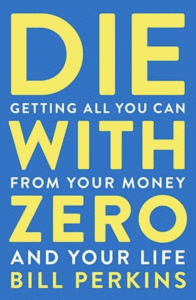The Royal Canadian Mint produces Canada’s coins and manages the national coin supply; there are currently five coins that are used in currency across Canada. The coins provide Canadians with a reliable and inclusive payment option even with credit cards, and digital payments available.
Did you know Canada has a 50 cents coin?
Many coins also have commemorative editions based on celebrations and anniversaries, whether of Canada or events in Canada. Many rare Canadian coins are also viewed as collectors’ coins that can be sold or cherished.
Coins are often rolled for organizational purposes; the rolls ensure that the coins are tightly packed for storage, transportation and knowing how many coins you have.
Each set of coins (nickel, dime, quarter, loonie, and toonie) has a specific amount that fits in a roll, meaning that the value of different rolled coins also differs.
The coin rolls tend to have a colour distinction for each currency; however, some rolls are now made of plastic.
The Canadian Coins In Circulation
Penny (one cent): A National Symbol
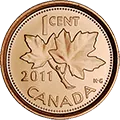
The penny is of copper-plated steel and features two maple leaves.
The Government of Canada stopped making pennies in 2013, and most prominent businesses and corporations will ask customers to round cash payments to the closest five cents.
Banks will still accept pennies; however, they prefer them rolled before exchanging.
Coinstar machines, some retail stores (ask first), and charities are other places to cash in pennies.
There are 50 pennies in a roll with a total value of $0.50. The coin rolls for pennies are red for easy differentiation.
Nickel (five cents): Industrious & Enduring

The nickel is made of steel, and features a beaver. Interestingly, the nickel is bigger, thicker, and heavier than the dime (10 cents). The nickel got its name because it used to be made of nickel.
After 2013 when pennies stopped being produced, the nickel became the smallest-valued coin in Canada.
There are 40 nickels in a roll with a total value of $2.00. The coin rolls for nickels are blue for easy differentiation.
Dime (10 cents): Pride & Skill
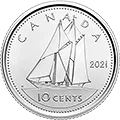
The dime is the smallest coin by size, even smaller than the penny! As well as being the smallest coin, it is the thinnest and the lightest coin.
The dime has a design of the fastest racing ship in Canada, the Bluenoseschooner, to symbolize the Canadian fishing industry and maritime skills. The term dime is influenced by the French word dîme (tenth part).
There are 50 dimes in a roll with a total value of $5.00, making it the most densely packed roll. The coin rolls for dimes are green for easy differentiation.
Quarter (25 cents): A Familiar Face
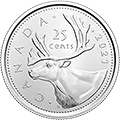
The quarter is named because it’s worth a quarter of a dollar. In addition, it features a caribou, an animal that resides in many parts of Canada. For commemorative occasions, the quarter has been known to show other images.
There are 40 quarters in a roll with a total value of $10.00. The coin rolls are orange or plastic for easy differentiation.
50-Cent Coin: From Sea To Sea
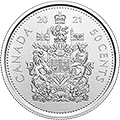
The 50-cent coin is one of the first Canadian coins created. It is still being produced today by the Royal Canadian Mint. It features the Canadian Coat of Arms with three maple leaves. The Arms are of England, Scotland, Ireland, and France.
The 50-cent coin is not often used for commerce. However, it is popular amongst coin collectors. Commemorative and older 50-cent coins have more value than more recently made ones.
The Royal Canadian Mint sells 50-cent rolls with 25 coins in a roll, and the total of the roll comes to $12.50.
Loonie (1 dollar): Striking In Its Solitude
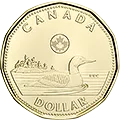
The loonie was produced to replace the one-dollar bill as a cost-saving measure. It is named the ‘loonie’ because of the loon featured on the coin, has eleven sides, and is made of gold-coloured nickel.
There are 25 loonies in a roll with a total value of $25.00. The coin rolls are brown/black for easy differentiation.
Toonie or twoonie (2 dollars): Balance & Composition
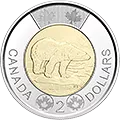
The toonie features an adult polar bear on an ice float. The toonie was introduced to replace the two-dollar bill and is made using a bi-metallic coin locking mechanism.
Therefore, it has two different colours of metal. It has been around almost twenty times longer than paper currency. The name ‘toonie’ comes from the combination of two and loonie.
The toonie is the highest monetary value of all current circulating Canadian coins. There are 25 toonies in a roll with a total value of $50.00. The coin rolls are purple for easy differentiation.
Coin Roles & Their Value
| Coin Name | Coin Value | Number Of Coins Per Roll | Total Roll Value |
| Penny | $0.01 | 50 | $0.50 |
| Nickel | $0.05 | 40 | $2.00 |
| Dime | $0.10 | 50 | $5.00 |
| Quarter | $0.25 | 40 | $10.00 |
| Loonie | $1.00 | 25 | $25.00 |
| Toonie | $2.00 | 25 | $50.00 |
Where To Get Rolls Of Coins
For the average person, the bank is the easiest way to get current rolls of coins in circulation. So, if you go to your favorite bank, there should be little to no problems getting rolls of coins.
However, other banks may have policies that allow customers to exchange rolls of coins with cash, or some banks might put a limit, or charge extra for obtaining rolls of coins.
For collectors, there are options to get special rolls of coins. Some mints will sell registrations through their website, and other coin distributors often sell rolls of coins on eCommerce sites.
Where To Get Empty Coin Rolls
Banks are the easiest way to get empty coin rolls. The banks will also give them to customers for free. However, they may limit how many they can give out.
Coin rolls can be bought at online retailers like Amazon and eBay.
Local retail stores such as Canadian Tire Corporation, and other chains also sell empty coin rolls.
Where To Deposit Rolls Of Coins
Banks are the easiest way to deposit rolls of coins. Due to different bank policies, some banks may accept loose coins, although most prefer and require them to be rolled. Depositing at banks enables them to increase their coin inventory to supply to other customers who may rely on coins.
In addition, local businesses might take rolls of coins since they often need change in coins when making transactions with their customers. However, this is not a given, and businesses are not required to take your rolls of coins; therefore, just make sure to ask beforehand.
Coinstar kiosks are another great way to deposit your coins, and they exist in many grocery stores in Canada. For these kiosks, you do not need to roll your coins; it counts all your loose change. Unfortunately, they have a processing fee when using the kiosks, so keep that in mind!
Are Coins Still Important?
The short answer is YES! The pandemic pushed many individuals and businesses to use electronic payments rather than cash and coins. However, people in remote and rural areas who do not have easy access to banking needs or who do not have steady access to the internet can rely more on cash and coins daily.
Laundromats and car washes are common places where people use coins, sometimes the only option! Sometimes tolls also only take exact change or vendors at events.
Even if you choose not to want to keep your loose change around, that is not a problem since you can take your change, roll it up and deposit it into a chequing or savings for future use!
Coins also have a longer lifespan, unlike our bills, which can more easily get damaged. Coins can be used for a long time before being reused to make new coins.

